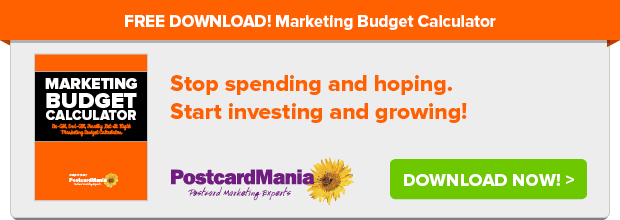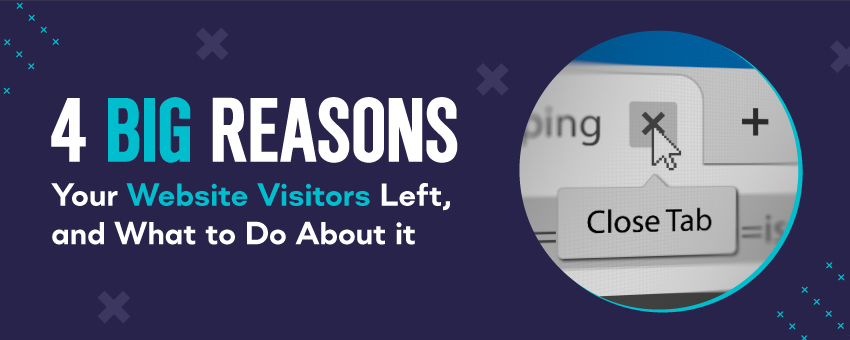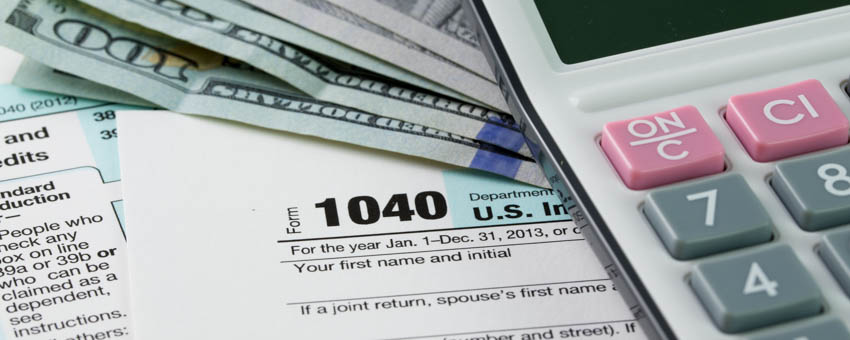4 Big Reasons Your Website Visitors Left, and What to Do About it
Updated on April 23, 2025Do you know how many people visit your website every day? Whether you get 1 person or 1,000 to your site every day, every person that visits has the potential to turn into a customer — think about that…
So how do you turn as many of these visitors as possible into customers? And, why are they leaving instead of purchasing or submitting a form to request more information from your company? Keep reading to find out the 4 main reasons your website visitors left and what to do about it.
We know that you’ve taken time, energy, and money to attract people to your website.
TRUST ME…
I’ve been there. I’m still there!! (But now we kind of rule at it.)
That’s why it’s so important to get your return on investment and not only attract website visitors but convert them into customers.
The reality is that 95% of interested prospects will visit your website before contacting you.
Wow! That means most people won’t even consider buying from you until they’ve seen your website first, and that makes up the majority of your leads.
But here is the sad truth…
Of that 95% — the potential customers who took their precious time to look at YOUR website before calling — the majority are going to leave without spending a dime or submitting a lead form to request information from your company.

While no one can really determine with 100% certainty exactly why they left, I’ve found there are three main reasons based on my extensive personal experiences in marketing over the decades.
Here are the top three reasons your website visitors are leaving and what you can do to fix it to ultimately convert more visitors into leads and sales…
1. They didn’t find the information they were looking for.
I’m sure you’ve been in this situation before: you Google an item or topic, click on one of the first links you see, and then don’t find the item or information you wanted.
For example, let’s say your daughter wants to do gymnastics, and you need to find a studio nearby and within your budget that offers classes outside of school hours.
You find a dance studio website, and it looks fun and professional, but it doesn’t list class times or prices.
Are you going to stick around and call them to find out? Probably not. You’re going to move on to the next studio.
Or, imagine you want to redesign your yard and want to know what the process is like. Where do you start? How long will it take? However, the website is difficult to navigate, and you have to dig to find the answers — with time you just don’t have.
How frustrating!

There will always be a percentage of visitors who get to your company’s website and then realize you don’t have what they were looking for — or who simply can’t find it.
So what does this have to do with your website?
Well, the best thing to do is make 100% sure your website is painfully clear what it’s about. You’ll keep visitors when they know exactly who you are, what you sell, and why they should choose you.
The best part about this is you’ll keep the right types of visitors (aka qualified leads) on your website longer because it provides the right information in a way that is easy to find, understand and digest.
SOLUTIONS:
Get a past customer, friend, family member, colleague, professional consultant (or even me!) to review your website and give essential feedback.
You won’t really know why people leave your website or why it doesn’t appeal to them until you ask! Find some people to look at your current website and give you an honest review. You can even get these opinions from a variety of people, like your neighbor or a trained professional.
At PostcardMania, we have digital marketing specialists who can give you a FREE website analysis when you sign up for a marketing campaign with us. They can study your website in-depth and then give you action steps to improve it. Just email us at info@postcardmania.com for more information.
I also have a great guide on what makes a website design good or bad, and you can find it here.
Here’s a good example of a website we designed:
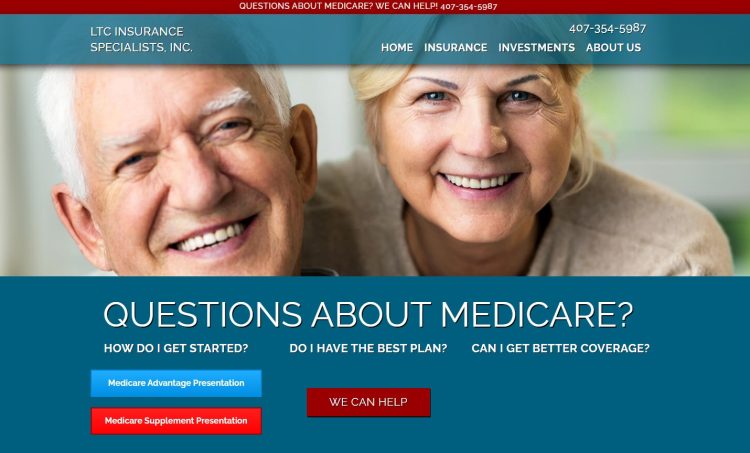
Once you have done the research, you can start tweaking your website. Keep in mind that you don’t have to have tons of disposable income to make the web changes you need to increase leads.
Start where you can!
Photos and videos do not have to be taken by a hired professional in order to provide your visitors what they are looking for, but it does help. The more professional your site is, the more professional YOU are because perception is everything. Folks don’t know you — they know your site and determine their like or dislike of you and your business based on that site experience!
If you want to take the photos yourself to save money, invest in some inexpensive lighting on Amazon, and I’m sure you can take tons of photos with your iPhone, and they’ll look good enough. But if they don’t, keep at it until they do.
You can also make a list of the most important pieces of information you think your customers need to make an informed decision, like:
- services/products list with prices
- hours
- team members
- about us section
- address
- photo gallery
Potential customers LOVE to see real photos of you, your team, your products or services — and they can always tell if it’s a stock photo from some other website. REAL people, you, your staff (whether beautiful or not) resonate with consumers far, far more than stock photos. We are trying to increase your site’s likability with the visitor and this is a surefire way to do it.
- Provide easy-to-read content on your website, causing the visitors to dwell on it longer.
This can be achieved by:
- Creating multiple web pages: Describe who you are, including your team members (bonus points if you include photos — even just iPhone photos!), your service or product, why you started the business, why your product is of value, how they can benefit from using the products, video testimonials, etc… The sky is the limit!
- Adding a blog: If you feel you have enough topics to post some articles, jot some ideas down and post when you can. If you are intimidated at the thought of writing, you can always hire a freelancer on a site like Fiverr. Give your writer a good prompt and a thorough outline.
The more content your website has, the more it will help boost your search engine rankings so that you land on the first page of Google. Ranking organically (or without paying) on Google is the long game, whereas Pay Per Click is the short game. It will take you longer and more manpower to achieve good organic SEO (Search Engine Optimization) by creating multiple web pages, but it does pay off in the long run.
PostcardMania offers blog design and installation here.
On this note, I’ll ask you a final question.
Do you tend to buy products you know a lot of information about, or know very little about?
I don’t know about you, but I read labels — in the grocery store on the back of the ketchup containers, in the spa on the back of the bottles of cream, in the department store on that little tag on the piece of clothing.
I want to know what’s in it, what it’s made of, where it’s from, and what it can do for me.
People buy when they have ALL the information. So give it to them. It’s what they came to your website for in the first place.
Yes, it does take more time and money to do it. But do you want all these visitors to leave, or do you want them to stay, purchase, and then come back for more?
2. They didn’t feel like they could trust you.
What causes you to trust someone?
Honestly, what does it take?
The reality in our current, spam-rich world is that people are less likely to trust you right off the bat — just because you are new (to them) and things are easy to fake in the online world.
And that’s no fault of your own. They just found you, and now you have to build up that trust with them.
Anyone who has been scammed in the past will have an even harder time handing over their hard-earned money and personal information. Let me give you a scenario a friend of mine shared with me.
She was on Instagram one day when a person reached out to her with an offer of a free bathing suit. All she had to do was use the offer code, FREESWIM20, pay for shipping, and she would get it in the mail.
She thought she would investigate, so she clicked on their Instagram page, browsed it for 30 seconds or so, then clicked on the website link to do more research. The website was beautiful. It had gorgeous pictures of men and women in nice swimsuits and information about what they were made of.
Everything looked right.
She entered the offer code, paid for shipping, and then waited eagerly for it to come in the mail.
And then waited. Aaaaaannnnnd waited. Months and months passed. She sent emails to customer service, and she was constantly reassured it would arrive.
Then one year passed…..she never got the swimsuit.
In this scenario, the website looked nice, and there was plenty of information about the product, but the result was atrocious.
A pretty website with lots of great photos and content is no longer enough to get folks to trust you.
They need extra affirmations that you are an honest, legitimate business that cares about their needs.
I know you’re thinking…

The thing is — no one knows that right away.
But everyone knows about scams like this.
So, as consumers, we all have an element of fear that we need to overcome when we first interact with a new business.
And, as business owners, it’s our job to do everything we can to help consumers overcome that (somewhat irrational) niggling feeling that says, “Don’t give them your information!”
SOLUTIONS:
- Use automated direct mail —like our solution Website to Mailbox —to legitimize your business.
If you’ve ever moved to a new city and attempted to get a library card, driver’s license, really anything of importance, you need mail proving that you are an actual resident of that community. There’s something about the legitimacy of mail — the tangibility maybe? — that’s hard to deny.
In the world of business, sending a mail piece shows that you have an address, a location, and a legitimate person running it.
If you already have their home address, great! Use it as often as you can to send direct mail. But, what if you don’t have their address?
I have good news! Hope is not lost. You can send direct mail to your website visitors automatically through our new product Website to Mailbox.
Website to Mailbox is a special technology we developed at PostcardMania that finds the physical location of website visitors, matches it to an address, and automatically sends them a postcard within 24 hours of their website visit.

It’s extremely new, but I loved it so much that I jumped on the opportunity to add it to our services and products list.
When I tell people this is possible, many of them are still baffled but impressed, and it works.
Why is this solution so valuable?
Two reasons:
–You are gaining their trust by proving to them you are a legitimate business.
–You are securing another opportunity to remind them about your product or service.
People need assurance AND reminders. Sending postcards to website visitors meets both of those needs.
You can learn more about Website to Mailbox and how it works here.
- Add reviews to your website to prove your trustworthiness. (Not testimonials!)
Another way to earn prospects’ trust is to provide plenty of current reviews. You may be worried that an unhappy customer will leave a bad review and ruin your chances of landing the sale, but the key isn’t to eliminate ALL bad reviews. The key is to provide a good ratio of good reviews to bad reviews and do your best to respond to and resolve the negative ones. Check out my Google reviews – you’ll see mostly 5-star reviews and a tiny percentage where folks hate our guts. It happens. But you’ll see how we handle those right there, and you’ll see an overwhelming amount of positivity and love for us. Transparency increases trust. See how you feel about PostcardMania after reading some. 🙂
Give your customers multiple opportunities to leave reviews and make it super easy for them.
There are lots of different software companies you can use to help facilitate the process, but you have to create a process in your company whereby you seek out good reviews. We use Podium because it makes the process fast and easy. In just one month, we generated 25 5-star reviews, and our 1-star reviews diminished by over 50%.
Reviews prove to your website visitors that you are a real and honest business that isn’t afraid to show what people think about you. It will encourage them to make a purchase and then provide their own opinion too.
You can read more about the process of receiving reviews here.
- Use real photos of your staff (not stock images) to show you’re a legitimate business.
I covered this point earlier, but it is such great advice, it’s worth mentioning again. Adding candid photos of your team will not only make your website look nice, but it will also increase visitors’ trust. Purchasing stock images from a website online is the easy way out for companies; taking the time to capture every-day photos of your business takes extra effort, and your prospects will notice this and appreciate it!
3. You aren’t doing a good enough job capturing their information with a compelling offer.
Imagine for a moment that you are looking for a lawn service company to take care of your yard. You Google “lawn services [your city]” and click on one of the first websites that come up. As soon as you click and get to the homepage, a small box pops up on your screen and says, “Claim your free mow now!” and then asks for your email.
Would you be compelled to leave the website at that point? Or would you be tempted to stay and get that free mow?!
The truth is, offers are the bread and butter of marketing tactics. Most people’s attention is swayed by the lure of a free item or discount.
You can incorporate offers onto your website with what we call a lead capture form or a pop-up.
It looks like this:
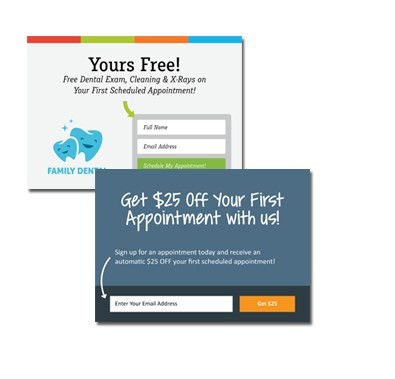
As a result, both of you will win! They will receive an item or discount they want, and you’ll get their contact information, which can be used to send them more deals and advertisements about your products and services.
You know that saying, “work smarter, not harder”? With this strategy, you are definitely working smarter, and it doesn’t take a lot of manpower to add it to your website.
So pick an offer you know your website visitors won’t be able to resist, and then place the pop-up form on your website.
Of course, you’ll have to strike a balance between what you can afford to give away and how valuable a new lead/customer is for you. A free lawn mowing might be too much to offer, but chances are you’ll be converting more leads than ever. Offering 50% off a mow might be a perfect compromise — it’d be hard to pass that up as a consumer, and you’ll at least recoup some costs for the time and resources spent on that mow.
The key is tracking your offer’s effectiveness. How many leads does it provide and how many of those turn into sales? How does that change if you change your offer slightly? We can do all this for you (click here to find out how) if you don’t have a web developer at your side who can accomplish this task.
Even better news:
A great offer that convinces someone to stay on your site and convert means your website visitors will stay connected to your brand for a longer period of time. It doesn’t give them the option of simply leaving if they want the coupon or free item. The people who want to receive the offer will have to hand over their personal information to receive it, which means you’ll have more opportunities to make a positive impression on them.
Which brings me to my next point about customers wanting more time…
4. They needed more time to make a decision.
I’m sure a lot of things go through your mind when you are choosing to buy something.
Can I afford this?
Is this exactly what I want?
Are there other brands that have better products or better prices?
According to McKinsey, the number of brands consumers typically consider ranges between 1 and 4. The study revealed people shopping for a new car looked at an average of 3.8 brands, while people shopping for a skincare line considered 1.5 brands.
This reveals that your website visitors are often considering other businesses while they look at yours, and they are taking time to do their due diligence before picking one.

Furthermore, bigger and more expensive purchases often have longer sales cycles because people perform even more research and comparisons.
I’ve said many times that in marketing, it’s okay to be a bit annoying. People need reminders, and it takes time, after time, after time, of consistent messaging to land a sale.
How do you engage them?
SOLUTIONS:
- Start follow-up digital ads to raise awareness of your brand.
As I mentioned before, people need time to make a purchasing decision. However, time isn’t a huge hurdle to overcome if you are consistent in your follow-up marketing strategies.
Remember, in our mobile world, people spend a lot of time online — on social media, browsing websites, etc.
According to Statista, in 2020, Americans spent an estimated average of seven hours and 50 minutes with digital media a day. This is a dramatic increase from 2015 when the daily time spent was around 5 and a half hours.
Follow-up digital ads that appear on sites like Facebook, Instagram, and Google are great ways to make more impressions on your prospects.
What exactly is an impression? You may have heard that term before.
Impressions are the amount of times a digital ad appears on someone’s screen.
I’ll tell you a story…
One day I was on Instagram scrolling through my feed when I saw an ad for a healthier alternative to coffee. There was a short video of a woman drinking a hot beverage called “mud water.” In those brief 30 seconds, I learned the drink powder had mushrooms, antioxidants, and other substances for mental clarity and energy.
I didn’t buy it the first time I saw it. But I saw it time and time again in my social media feeds that I started to think about actually trying it! And I may still buy it. I haven’t decided yet. 😉
I was a victim to my own marketing advice!
When it comes to digital follow-up ads, maybe the web user will click on it, maybe they won’t. But their brain saw it. They read the company name, they assessed the brand imaging, and ingested the message.
These ads are also very convenient because in just one click, the online user is on the website.
We offer these follow-up ads in our Everywhere Small Business package because they are so effective at exposing online users to your brand and gently leading them back to your website. And I understand that it’s hard and time-consuming to use multiple agencies to make all your marketing work together. This package is simple and seamless and gets results. I’m super passionate about it!
- Use direct mail to engage your prospects about your services/products.
People interact with mail differently than they do with digital advertisements. The internet is heavily saturated with ads, so we’re becoming increasingly blind to these digital messages.
According to Infolinks, 86% of consumers suffer from banner blindness, which occurs when online users ignore or avoid banner ads.
Not only has the saturation of digital ads decreased the effectiveness of digital ads, but the cost of impressions and clicks has also risen dramatically over the past 3 years.
In a recent report, Digital Information World shows the cost of Facebook advertising rose 33% between 2019 and 2021. Further, Instagram costs per thousand appearances rose 23% over the same period, and Google’s per click cost increased 23%.
Due to the intense competition for ad space, the trajectory is for these prices to go up even more.
These costs have risen so much that marketing agencies and businesses alike have found a smaller price gap between digital ads and more traditional forms of advertising.
An article in Forbes Magazine revealed one particular marketing agency, Belardi Wong, began to shift their focus to find more economical ways of engaging with customers, like direct mail, catalogs, outdoor signage, and other direct communications with customers because of the high costs of advertising on Facebook, Google, Apple, and Instagram.
Not only is the price of direct mail getting closer to digital ad pricing, but also mail offers the prospect a break from the digital world and grabs their attention differently.
When a prospect gets a piece of mail, they can feel the postcard paper with their fingers, put it on their fridge, or keep it in their bag.
The interaction with a physical object causes the person to not only remember you better, but it also has the potential to stay with them for a long time.
According to a 2021 study by Storyblok on the effects of digital ads vs. printed ads, researchers found that immediately after exposure to both print and digital advertisements, there was no difference in memory. However, one week later, the subjects recalled the print advertisements better than the digital ones, and there was greater brain activity in the memory regions.
But wait…
Joy, didn’t you just encourage me earlier to do digital ads?

Both digital and print advertising have their place in your marketing strategy. Yes, both have the end goal of converting the web visitor into a customer. However, they get there on two different paths.
But should you do both?
If you can swing it, absolutely!
Personally, I would never send a postcard without a digital follow-up component at the ready — and I would NEVER switch to digital-only advertising.
Remember that cartoon Captain Planet?

Together, digital and print advertising make a very powerful combination.
Print ads make a deeper, longer-lasting impression on us, but digital ads are still effective at branding exposure and engagement.
The more you follow up with prospects and use different methods of intervention, the more you have a chance of converting them.
So use follow-up ads on social media and Google AND send them postcards.
Doing everything you can to beat your competition and stick with the prospect will be worth it. The reality is, if you aren’t doing it, someone else most likely is.
So, let’s recap…

Ninety-five percent of your website visitors left without giving you their phone number, email, or address — nothing. Ouch. Talk about feeling rejected.
You could assume your first date didn’t go well.
But you still have MORE opportunities to convince them otherwise, and that you’re awesome.
Automated postcards, follow-up digital ads, and a content-rich website with lead capture forms will all help win those web visitors back.
If you need more information on how you can use any of the solutions mentioned in this article, call a PostcardMania marketing consultant FREE at 1-800-628-1804. They will be able to tailor a marketing strategy that fits your needs and your budget.
